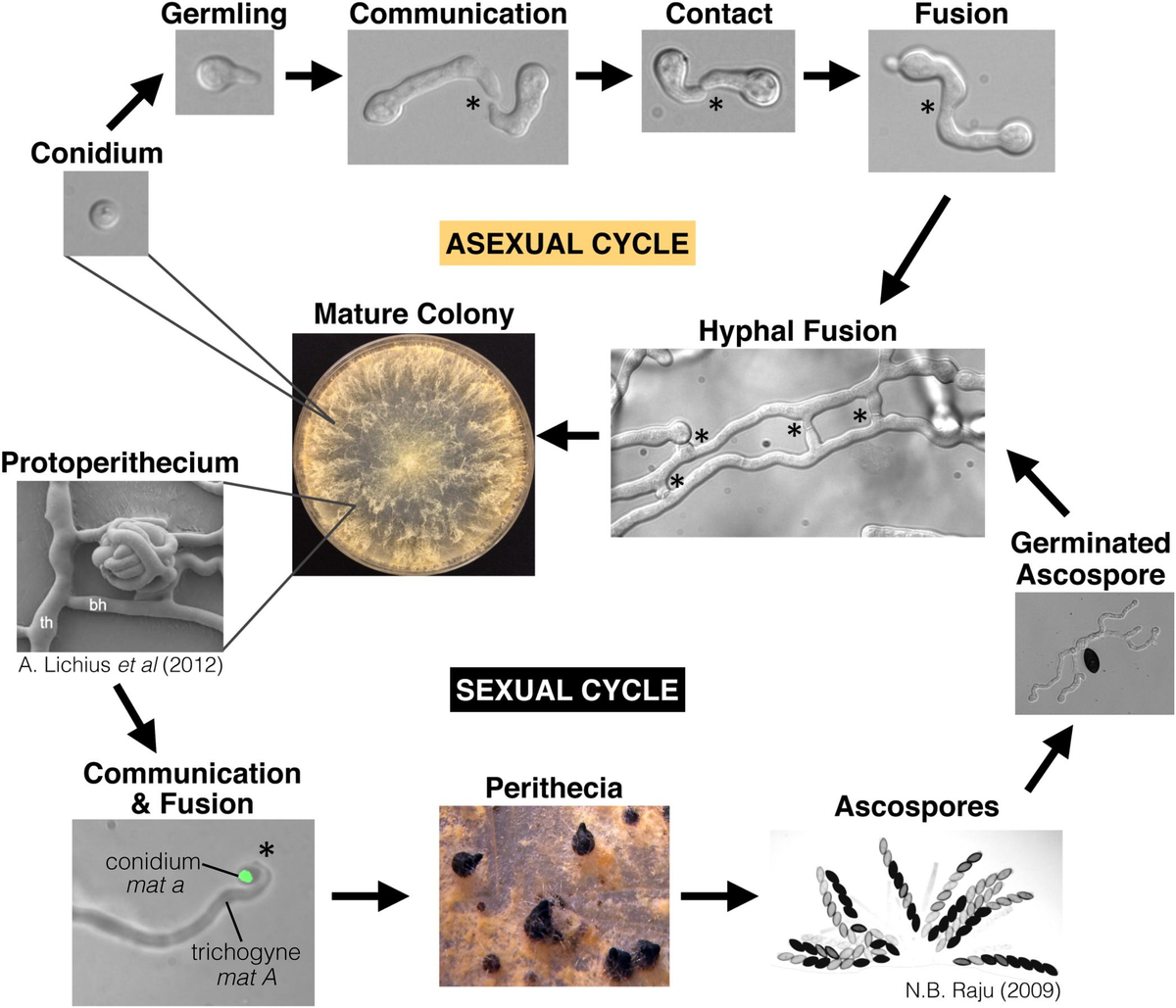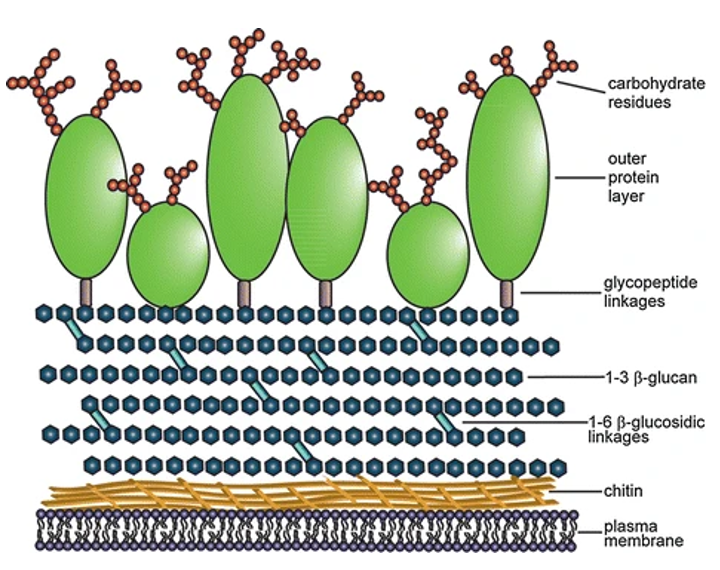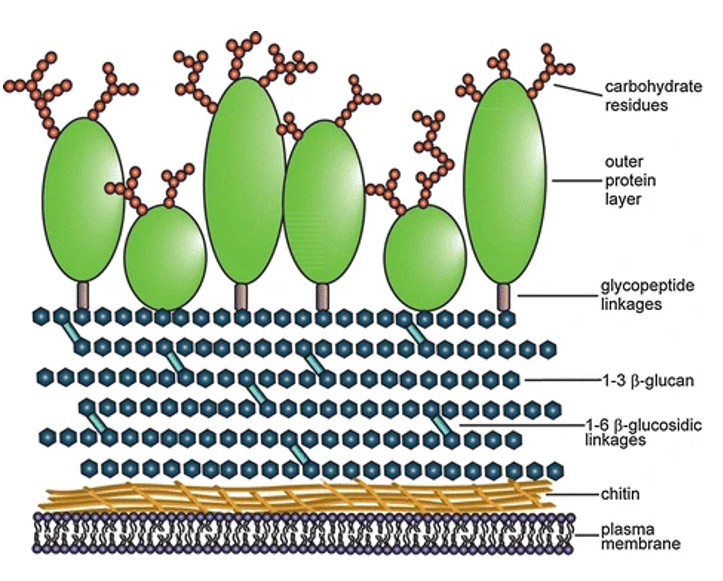Mycology -> Fungi
1/28
There's no tags or description
Looks like no tags are added yet.
Name | Mastery | Learn | Test | Matching | Spaced |
|---|
No study sessions yet.
29 Terms
Why are there fewer drugs for fungal infections compared to bacterial infections
Fungi are eukaryotes like human cells, offering fewer selective drug toxicity targets
Major challenge to develop antifungal treatments.
What is the phylogeny of the Fungi (Eumycota)
Fungi (Eumycota) are saprophytic, feeding on decaying matter using enzymes to absorb nutrients such as reduce carbon [heterotrophic]; they are eukaryotes and can break down keratin (e.g., athlete's foot) or pectin (e.g., oranges).
—
- All life are grouped into kingdoms (Bacteria, Archae, Eucarya (eucaryotes))
- Animal, Fungi and Plants are closely related. Fungi and plants are different as plants have roots, stems, leaves and photosynthesises to get reduced carbon.
- Fungi gets reduced carbon for mitochondria to make ATP from being saprophytic (feeding on dead matter).
- Fungi is a saprophytic microorganism where it can secrete enzymes to decay matter and then absorb the nutrients as a source of energy. [Sacrophytic eukaryotic microorganisms.]
What are mushrooms in relation to fungi? What is the main fungal body?
Mushrooms are not the entire fungus but a reproductive extension
The main fungal body is the mycelium in the soil.
Importance Of Fungi
- They are a major decomposer in the environment and very important for recycling (dead and decay matter) in the environment.
- Can cause diseases so they can transition between/ from commensal to parasitic state (can cause disease in animals, plants, humans, any live form)
- Can feed off keratinised structures (skin, hair, nail). [E.g. athletes foot feeding off keratinised skin encouraging further periodic drying]
- Can be used in research – almost everything known about cell metabolism has its origin from fungal research
- Can be a source of drugs for humans
—
"Fungi have contributed to understanding cellular metabolism and cancer through analysis, and some produce useful products like Depo-Provera (a contraceptive)."
What is the unicellular form of fungi
Yeast (Unicellular form)
Unicellular so reproduces through asexual reproduction via BINARY FISSION (becoming haploid) or BUDDING, where a daughter cell forms off the parent cell.
What is the mold form of fungi
Hyphae – Filamentous fungi
Formed of interwoven filamentous forms of hyphae, forming an interconnected mycelium, growing by apical extension, secreting enzymes to digest nutrients, and producing spores (e.g., chlamydia spores) for dispersal after colonization. – (hyphae are smaller than a human hair – microscopic)
Hyphal forms can grow by elongation at their tips.
At the end of the hyphae are rounded forms (sometimes confused by with yeast),
These are conidia / spores which will germinate to produce extensive hyphae filaments after it has been disseminated by wind, water or action of other organisms.

How are fungi classified by division
Fungi are classified by variations in sexual reproduction:
Zygomycetes (Zygomycetes, 600 species) [Bread mold]
Ascomycetes (Sac fungi, 35,000 species) [Morels (wild mushrooms) and truffles]
Basidiomycetes (Club fungi, 30,000 species), [Rusts, mushrooms (reproductive structure)]
Deuteromycetes (Fungi Imperfecti, 30,000 species, per traditional systems).
—
Sexual cycles are characterised by the formation of the spores and how the spores are released.
When a fungus lacks a sexual phase, fungi is classified into Deuteromycota (Fungi Imperfecti). Once sexual phase is observed, then classified as either zygomycetes, ascomycetes and basidiomycetes
The morphology of asexual spores are the same for many different fungi so morphology differences cannot be used to group fungi taxonomically.
How do Zygomycetes reproduce sexually
Zygomycetes fuse hyphae to form a diploid zygote
Thickens its cell wall
Undergoes meiosis
Releases spores for dispersal.
How does mold grow asexually on bread
Zygomycete mold on bread grows via hyphae spreading across the surface via apical extension, absorbing nutrients
When nutrients deplete, hyphae grow upward to form spore-producing structures, releasing black or blackish-green spores.
What is the process of sexual reproduction in fungi
"Fungi fuse haploid mating hyphae (+ and - types, not male/female), form a diploid zygote, thicken its cell wall, undergo meiosis to produce haploid spores, and restart the asexual cycle."
Why are Zygomycetes emerging pathogens
"Zygomycetes are emerging pathogens, especially in immunocompromised patients (e.g., uncontrolled diabetes, SARS-CoV-2 recovery), where inhaled spores exploit weakened immunity, as seen in India's black fungus outbreak."
What is black fungus infection
"Black fungus infection, widespread in India during COVID-19's second wave, affects immunocompromised individuals, causing cutaneous lesions, black spots, and potentially fatal central nervous system spread."
What is the mycelium stage in Ascomycetes
A mass of hyphae distinct from fruiting bodies (like mushrooms), both serving as reproductive structures for spore dispersal.
—
Ascomycetes life cycle
Asexual reproduction: Produce spore called conidia. Conidia disperse and germinate to form new hyphae.
Sexual reproduction- formation of haploid ascospores. Ascospores are formed inside a sac-like structure called ascus. Ascus are contained within ascocarps. Ascospores are released and germinate into new hyphae
What is ergot and its effects
Grains like rye, contaminated with Claviceps purpurea (which is a parasitic ascomycete). This fungus can produce ergot alkaloids.
Ergot produces toxic alkaloids causing ergotism (St. Anthony's Fire) toxic to humans, with symptoms like hallucinations, blood vessel constriction and uterine contractions.
What are the steps of the sexual cycle in Ascomycetes
1. Fusion of opposing haploid hyphae.
2. Formation of a diploid ascospore.
3. Meiosis producing haploid spores.
4. Spore dispersal from specialized structures (e.g., truffles, morels).
What are the steps of the sexual cycle in Basidiomycetes
1. Germination of haploid basidiospores into monokaryotic mycelia.
2. Fusion into dikaryotic mycelium.
3. Formation of a diploid zygote nucleus.
4. Development of a basidiocarp fruiting body.
5. Meiosis in basidia producing basidiospores for release.
How often do Basidiomycetes produce asexual spores
Basidiomycetes produce asexual spores less commonly
Can act as airborne allergens causing allergic reactions.
What are the several types of asexual spores in fungi?
Occurs through mitosis and subsequent cell division.
1) Arthrospores - Hyphae can fragment by separation of the hyphae through the cell wall producing cells that behave as spores.
2) Chlamydospores - Hyphae can be surrounded by a thick cell wall before separation giving rise to chlamydospores. They are thick-walled spores that help fungus survive under extreme conditions (e.g. seen in candida
3) Sporangia - Can develop spores in a sac at the hyphal tip ( e.g. Rhizopus which is responsible for the spoilage of food)
4) Conidia – Spores that are not enclosed in a sac but reproduce at the tip/sides of the hyphae. Are characteristic asexual dispersal form of fungal pathogen inc. Aspergillus.
5) Blastospores – Spores produced by vegetative mother cell by budding
Spores are important due to being an allergen typically causing asthmatic reactions. They are usually no harm but if one is allergic to funga spores, it could exacerbate an asthmatic reaction.
What toxins do Basidiomycetes produce
"Basidiomycetes (e.g., Amanita mushrooms) produce alkaloids like hepatotoxins, causing severe gastrointestinal and liver damage when ingested."
What are Fungi Imperfecti
"Fungi Imperfecti (Deuteromycota) lack a recognized sexual reproductive phase (perfect phase); they are classified as such until their sexual cycle is identified."
What is the perfect phase in fungi
"The perfect phase is the sexual reproductive stage producing specialized spores via meiosis, used to classify fungi (e.g., Ascomycota for ascospores, Basidiomycota for basidiospores)."
What is the composition of fungal cell walls
"Fungal cell walls are composed of chitin (a polysaccharide of N-acetylglucosamine), making them insensitive to antibiotics targeting peptidoglycan synthesis (found in bacteria)."

What is the composition of fungal cell membranes
Fungal cell membranes contain ergosterol instead of cholesterol (found in human cells), enabling selective antifungal drug targeting.
What is dimorphism in fungi
Dimorphism is the ability of fungi to exist as:
Y-form (yeast, unicellular)
or
M-form (mycelium, multicellular)
Influencing their potential to cause disease.

What are cutaneous mycoses
"Cutaneous mycoses affect keratinized tissues (skin, hair, nails), causing conditions like ringworm, tinea, athlete's foot, and nail bed discoloration."
What are subcutaneous mycoses
"Subcutaneous mycoses involve chronic abscess formation with pus discharge through sinuses containing granules, often from puncture wounds, triggering hypersensitivity (e.g., Madura foot)."
What are systemic mycoses
"Systemic mycoses result from inhaling dimorphic fungal spores, starting asymptomatic but potentially disseminating into destructive, fatal lesions in immunocompromised individuals (e.g., histoplasmosis, blastomycosis)."
What are opportunistic mycoses
"Opportunistic mycoses occur in impaired immune systems, including candidiasis (thrush), aspergillosis (lung infections), and cryptococcosis (fatal meningitis from yeast dissemination)."
Fungal Cell Wall Structure
Carbohydrate residues
Outer protein layer
Glycopeptide Linkages
1-3 β-glucan
1-6 β-glucosidic Linkages
Chitin
Plasma membrane
